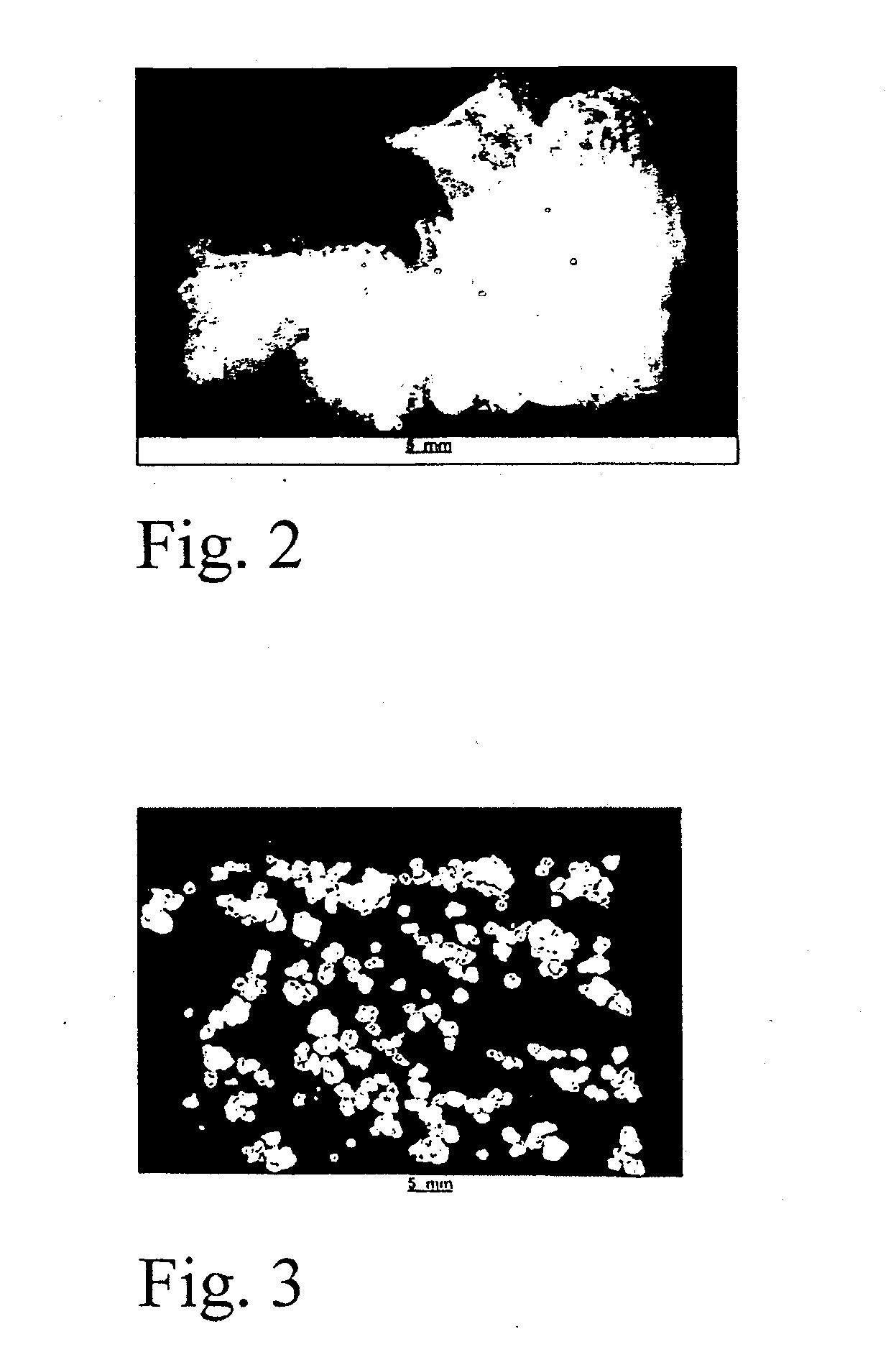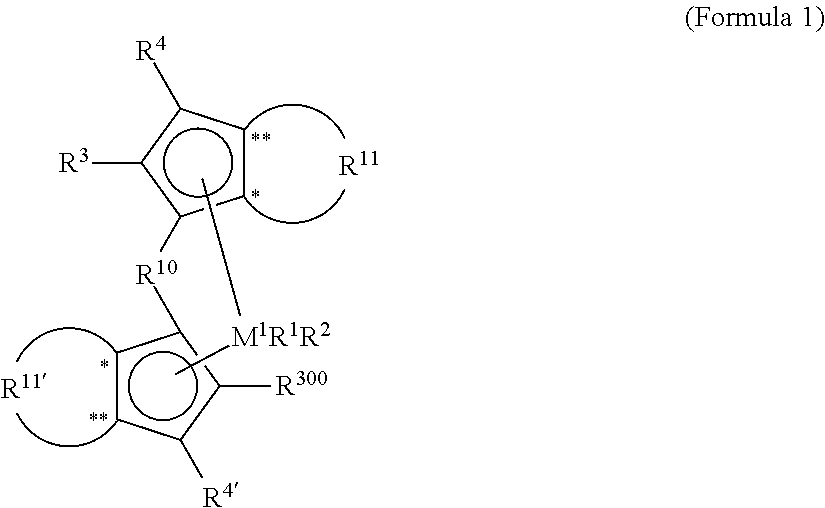Metallocene compounds, catalysts comprising them, process for producing an olefin polymer by use of the catalysts, and olefin homo- and copolymers
a technology of olefin polymer and catalyst, which is applied in the direction of catalyst activation/preparation, organic compound/hydride/coordination complex catalyst, and metalocene catalyst for polypropylene, which can solve the problems of inability to produce propylene-ethylene copolymers of high molar mass, and inability to prevent the -hydrogen transfer to the ethylene comonomer, etc., to achieve high melting point, high molar mass
- Summary
- Abstract
- Description
- Claims
- Application Information
AI Technical Summary
Benefits of technology
Problems solved by technology
Method used
Image
Examples
example 6
Dimethylsilandiylbis[2-[(1-methylcyclohexyl)methyl]-4-(4-tert-butyl phenyl)-1-indenyl]-zirconium dichloride
2-(2-Bromo-benzyl)-malonic acid diethyl ester
[0489]
[0490]In a 4-neck 4 l round bottom flask equipped with a reflux condenser, gas outlet, thermometer and stirrer are placed 2 l of ethanol. A solution of sodium ethoxide in ethanol is prepared by gradually adding 25.5 g (1.11 mol) of sodium cut in small pieces to the reaction mixture. At a reaction temperature of 40-45° C. the sodium addition and reaction is finished after ˜1.5 h. The solution is cooled to room temperature and 192.5 g (1.20 mol) of malonic acid diethyl ester are added. The mixture is stirred at this temperature for 15 minutes. Then 250 g (1.00 mol) 2-bromobenzyl bromide are added via a dropping funnel in a way that the reaction temperature raises to 40-45° C. After the addition is completed the reaction mixture is heated to reflux for 3 h.
[0491]For workup, most of the ethanol is distilled off, and 300 ml of water...
example 7
Dimethylsilandiylbis[2-[(1-methylcyclopentyl)methyl]-4-(4-tert-butyl phenyl)-1-indenyl]-zirconium dichloride
Aldol condensation between 4-(4-tert-butyl-phenyl)-indan-1-one and 1-methyl-cyclopentanecarbaldehyde
[0514]
[0515]15.4 g (58.3 mmol) of 4-(4-tert-butyl-phenyl)-indan-1-one, 6.9 g (61.5 mmol) of 1-methyl-cyclopentylcarbaldehyde, 10.8 g (78.1 mmol) of potassium carbonate and 160 ml of ethanol are placed into a round bottom flask. The mixture is heated to a temperature of 76-78° C. with stirring for 50 h. 10% hydrochloric acid is added until no gas evolution is observed anymore and the precipitating salts are dissolved by adding enough water to dissolve them. The aqueous phase is extracted twice with 150 ml of methylene chloride. The combined organic phases are dried over MgSO1 and the solvent is removed in a vacuum to yield 21.1 g of crude product. The crude product was used as-is for the subsequent steps.
Hydrogenation of 4-(4-tert-butyl-phenyl)-2-[(1-methylcyclopentyl)methylene]-...
example 8
Dimethylsilandiylbis[2-[(1-ethylcyclohexyl)methyl]-4-(4-tert-butylphenyl)-1-indenyl]-zirconium dichloride
Aldol condensation between 4-(4-tert-butyl-phenyl)-indan-1-one and 1-ethyl-cyclohexanecarbaldehyde
[0524]
[0525]18.6 g (70.4 mmol) of 4-(4-tert-butyl-phenyl)-indan-1-one, 10.3 g (73.5 mmol) of 1-ethyl-cyclohexylcarbaldehyde, 13.0 g (94.1 mmol) of potassium carbonate and 160 ml of ethanol are placed into a round bottom flask. The mixture is heated to a temperature of 76-78° C. with stirring for 50 h. 10% hydrochloric acid is added until no gas evolution is observed anymore and the precipitating salts are dissolved by adding enough water to dissolve them. The aqueous phase is extracted twice with 150 ml of methylene chloride. The combined organic phases are dried over MgSO4 and the solvent is removed in a vacuum to yield 25.9 g of crude product. The crude product was used as-is for the subsequent steps.
Hydrogenation of 4-(4-tert-butyl-phenyl)-2-[(1-ethylcyclohexyl)methylene]-indan-1-...
PUM
| Property | Measurement | Unit |
|---|---|---|
| temperatures | aaaaa | aaaaa |
| temperatures | aaaaa | aaaaa |
| temperatures | aaaaa | aaaaa |
Abstract
Description
Claims
Application Information
 Login to View More
Login to View More - R&D
- Intellectual Property
- Life Sciences
- Materials
- Tech Scout
- Unparalleled Data Quality
- Higher Quality Content
- 60% Fewer Hallucinations
Browse by: Latest US Patents, China's latest patents, Technical Efficacy Thesaurus, Application Domain, Technology Topic, Popular Technical Reports.
© 2025 PatSnap. All rights reserved.Legal|Privacy policy|Modern Slavery Act Transparency Statement|Sitemap|About US| Contact US: help@patsnap.com



